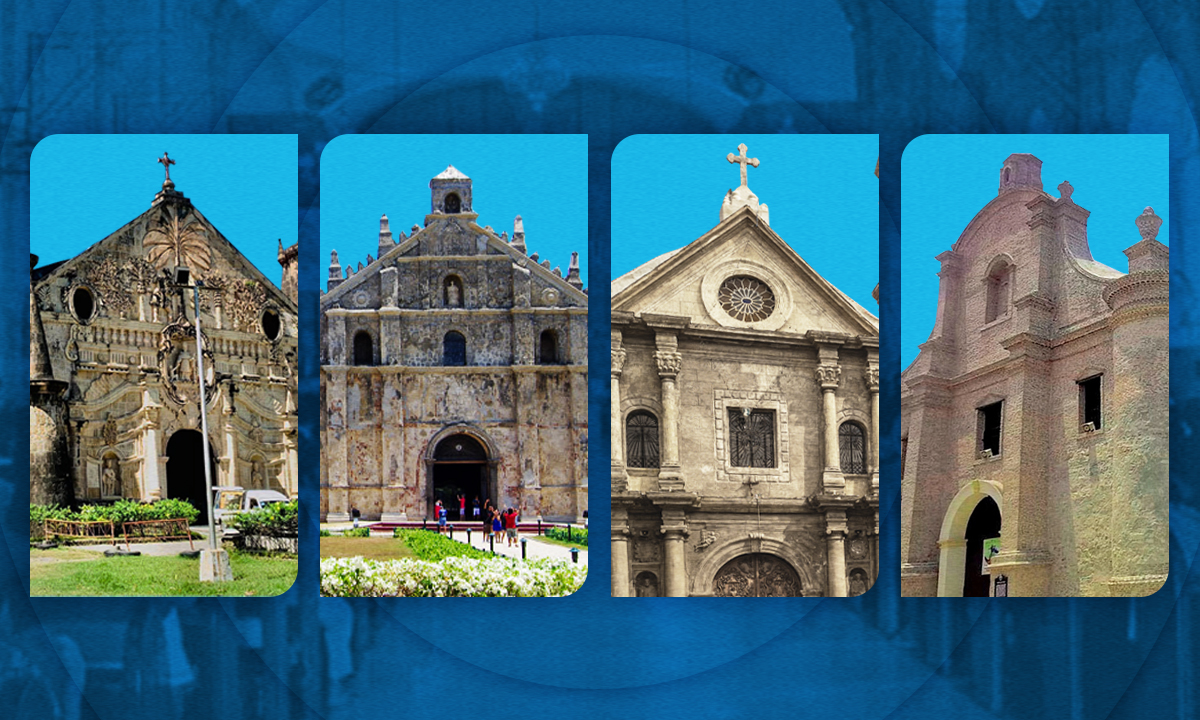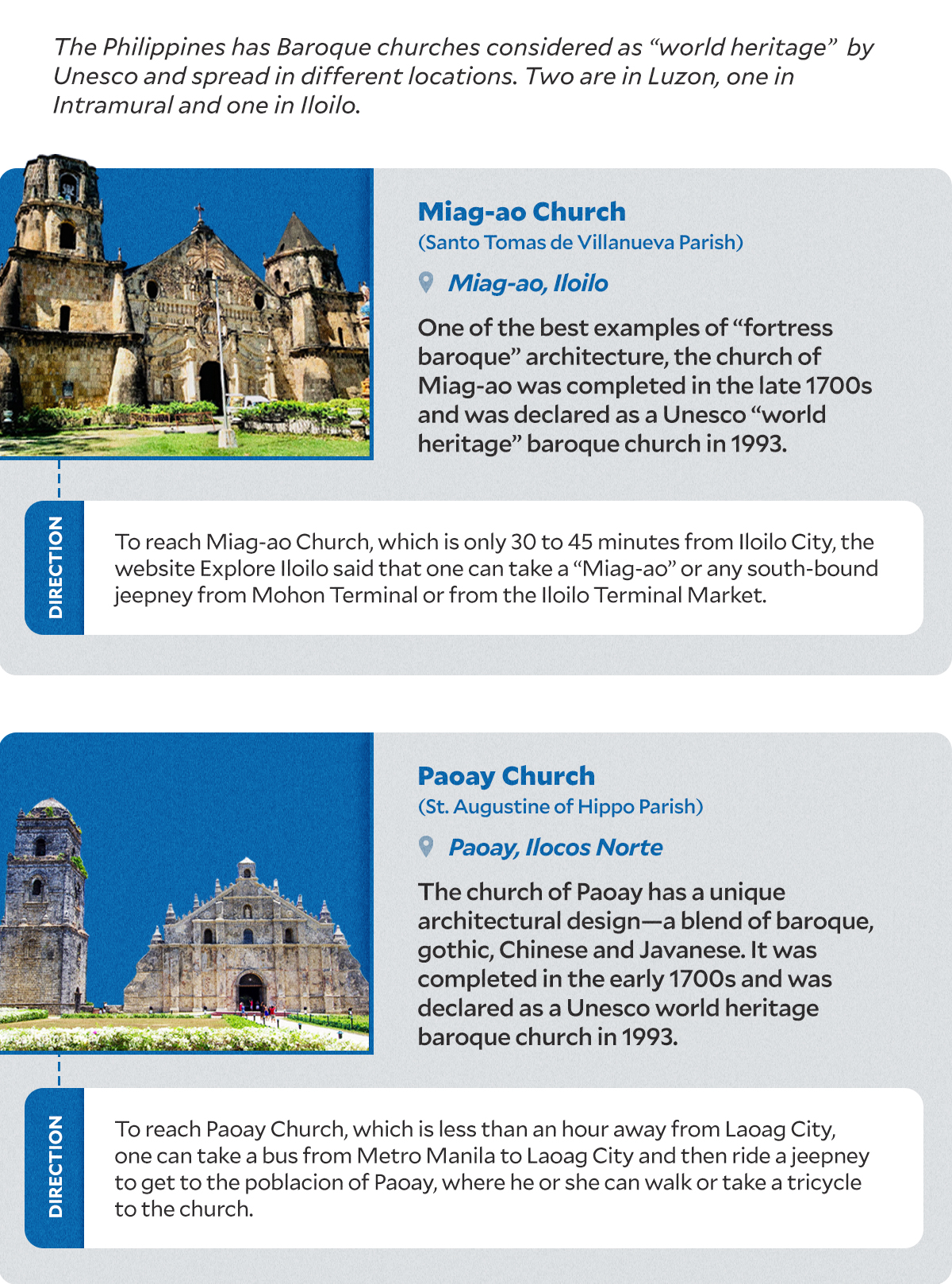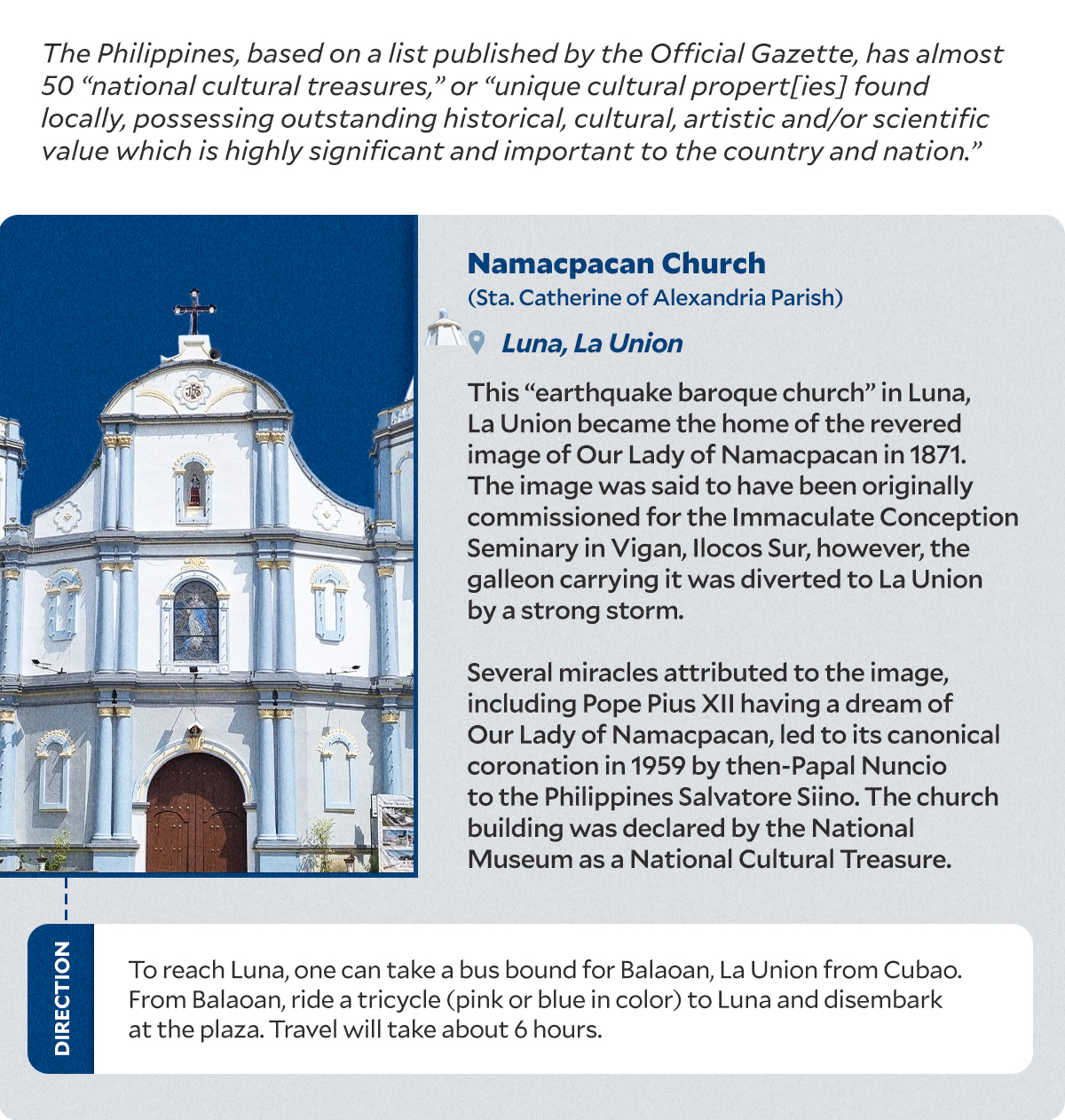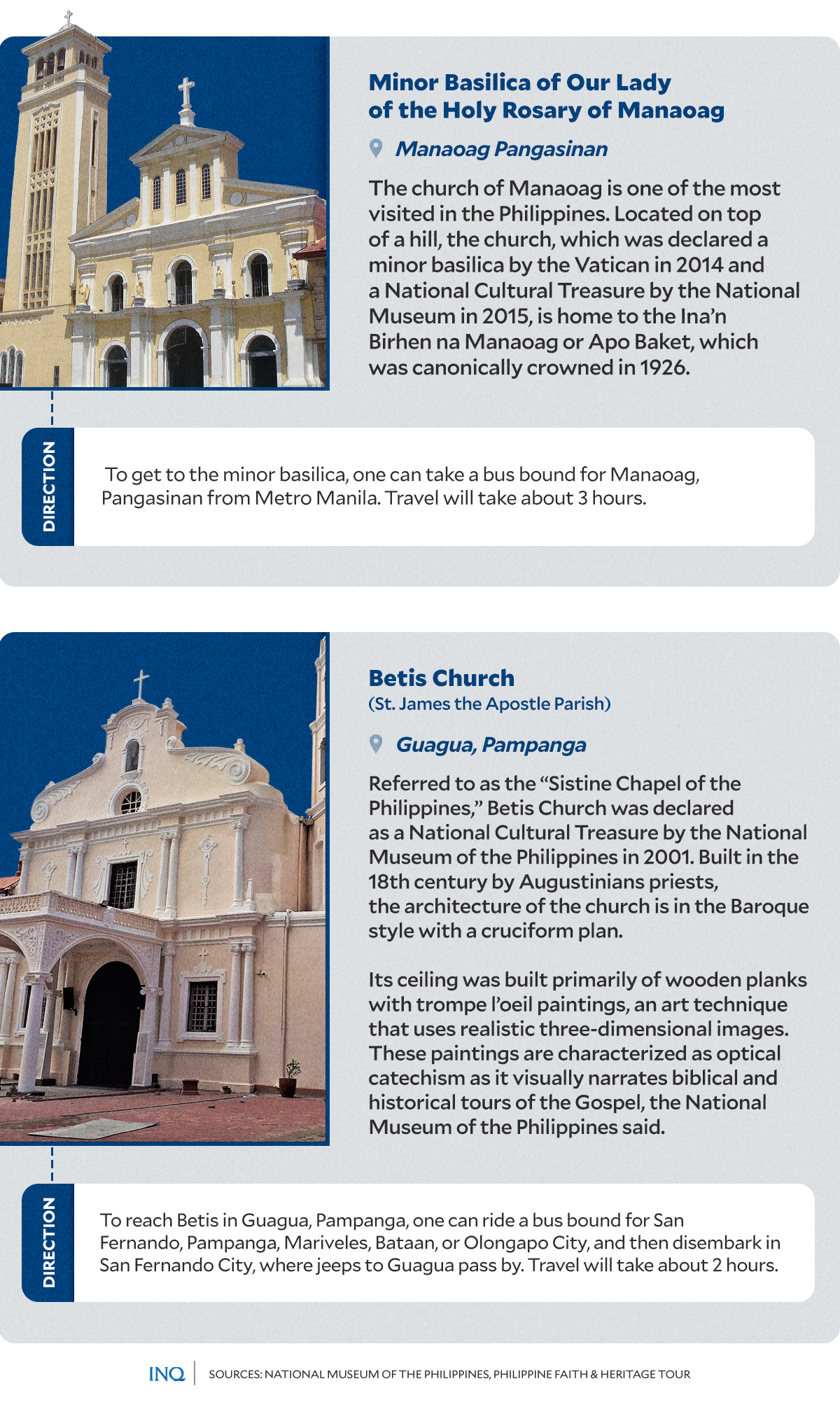
HERITAGE CHURCHES COMPOSITE IMAGE FROM INQUIRER, NATIONAL MUSEUM OF THE PHILIPPINES, CBCP FILE PHOTOS
MANILA, Philippines—As Semana Santa will be observed next week, panata, or sacred vows, which Filipinos commit to and heed, will be highly visible again—reciting the Pasyon, practicing penitensya, and most of all, the Visita Iglesia.
The International Catholic Biblical Society, or SOBICAIN, said that the Visita Iglesia, or church visit, is a pious Holy Week tradition in the Philippines, which is the stronghold of Catholicism in Asia with over 85 million Roman Catholics.
Visita Iglesia is said to have been started by St. Philip Neri in the 16th-century and was brought by Spanish missionaries to the Philippines. It was, however, initially intended as a way to adore the Blessed Sacrament at the Altar of Repose on the evening of Holy Thursday.
READ: ‘Visita Iglesia’
But as years passed, the practice became a kind of pilgrimage, especially on the days of the Holy Week, with people visiting seven or 14 churches to reflect on Christ’s passion and death, and seek penance for the sins they have committed.
Interestingly, as SOBICAIN pointed out, the number of churches to visit, be it seven or 14, corresponds to the seven last words or seven sacred wounds of Jesus. Some decide to visit 14 churches to match the 14 Stations of the Cross.
RELATED STORY: Undiluted devotion: Exploring Manila’s centuries-old tradition of Visita Iglesia
With this, as most Filipinos now think of where to go this Holy Week, INQUIRER.net lists down some heritage churches in the Philippines—churches that are well known either for their great architecture or for being “home” to revered images to which miracles are attributed.
READ: Lent: Catholics reminded that piety, sacrifice not just for show
‘World heritage’
Back in 1993, the United Nations Educational, Scientific and Cultural Organization (Unesco) declared four Baroque churches in the Philippines as “world heritage” for their outstanding “Philippine interpretation of the Baroque style.”
“[They] represent the fusion of European church design and construction with local materials and decorative motifs to form a new church-building tradition,” it said on its website.
These churches—in Luzon, Manila and part of the Visayas—are the Miag-ao Church, Paoay Church, San Agustin Church, and Santa Maria Church.
The Santo Tomas de Villanueva Parish in Miag-ao, Iloilo is considered as one of the best examples of a “fortress baroque” architecture. It was completed in 1797, over 10 years since construction started, according to the website of the local government of Miag-ao.
The church, best known for its “native style,” has an artistic facade decorated with a relief sculpture of St. Christopher carrying the child Jesus, and coconut, papaya and guava shrubs in the background.
The image of its patron saint, St. Thomas of Villanova, carved on a large stone, is at the center of the “Baroque-Romanesque” church that “sinks six meters deep into the ground with walls one-and-a-half meters thick and buttresses thrice thicker in size.”
It withstood natural disasters, like earthquakes, but not the ravages of the revolution against Spain in 1898 and the Japanese occupation from 1942 to 1944. The people, however, worked on rehabilitating the church, which was eventually recognized as a National Cultural Treasure by the National Museum of the Philippines (NMP) in 2014.
To reach Miag-ao Church, which is only 30 to 45 minutes from Iloilo City, the website Explore Iloilo said that one can take a “Miag-ao” or any south-bound jeepney from Mohon Terminal or from the Iloilo Terminal Market.
Established by Augustinian missionaries in 1593, the St. Augustine Parish was completed in the early 1700s and has since been well known for its unique architectural design, which is a blend of baroque, gothic, Chinese and Javanese.
Its three-story bell tower was constructed in 1793 and served as an observation post for Katipuneros against the Spaniards in 1898 and by Filipino guerrillas during World War II.
Paoay Church, the NMP said, is known for its distinct features such as the volutes of buttresses and pyramidal finials of its wall facades.
Its facade is rich with carvings depicting nature such as flowers, leaves, stars and human-faced sun. “Whorls that resemble those of conus shells could also be found on the facade, but are most prominent on the side buttresses.” It was declared a National Cultural Treasure in 1973.
To reach Paoay Church, which is less than an hour from Laoag City, one can take a bus from Metro Manila to Laoag City and then ride a jeepney to get to the poblacion of Paoay, and walk or take a tricycle to the church.
The San Agustin Church—Immaculate Conception Parish and Archdiocesan Shrine of Our Lady of Consolation and Cincture—is located in Intramuros, Manila. As described by the NMP, the church has an “outstanding universal value […] as a cultural and artistic monument.”
This all-stone church complex, completed in 1607, is the oldest stone church in the Philippines, staying relatively the same since its construction. San Agustin is built out of locally quarried adobe stone and lime mortar, and is designed in the Neoclassical-Baroque style.
The interior of the church contains several distinct architectural features. For one, the central nave of the church is topped by a barrel vault , broken by wall separations that divide the nave into six sections, and as the NMP said, the church is recognized as one of the few structures in the Philippines constructed with true barrel vaulting.
“A unique feature of the structural interior are the series of chapels lining both sides of the nave, these are originally fourteen cryptocollateral chapels, seven on either side of the nave; the walls separating these chapels act as buttresses (or structural supports), in the same manner as wandpfeiler (wall pillars) of German Baroque churches,” it said.
Most of the interior space of the church is painted in artistic trompe l’oeil, including all the interior wall surfaces, ceiling, and dome soffit. The San Agustin Church, where Miguel Lopez de Legazpi has been laid to rest, was declared as a National Cultural Treasure in 1973 by the NMP.
As stated in the website The Poor Traveler, if you take the LRT 1, alight at either Carriedo Station or Doroteo Jose Station to reach San Agustin Church. Travel will be about 10 to 15 minutes.
From Carriedo Station, take a Pier-bound jeepney and tell the driver to drop you off at Manila Cathedral. From Doroteo Jose Station, ride a Baclaran/Mabini jeepney and disembark at Intramuros.
The church of Santa Maria, Ilocos Sur was originally built as a chapel by the Augustinians in 1765, it became a parish church in 1769 having Our Lady of Assumption as its patroness.
It sits atop a hill and may be reached by climbing 85 steps made from imported granite rock. In 1810, its tower was built and was furnished with a bell the following year. Its thick buttresses on both sides provide protection from earthquakes, the website Philippine Faith & Heritage Tour stated.
To get to Sta. Maria, Ilocos Sur, one can take a bus to Vigan City from Metro Manila, and then take a ride to Sta. Maria, which is only less than an hour away. The Santa Maria Church was declared as a National Historical Landmark in 1974. It is considered as a National Cultural Treasure as well.
Great treasures
The Philippines, based on a list published by the Official Gazette, has almost 50 “national cultural treasures,” or “unique cultural propert[ies] found locally, possessing outstanding historical, cultural, artistic and/or scientific value which is highly significant and important to the country and nation.”
Some of the structures on the list are the four Unesco World Heritage Baroque Churches, the Namacpacan Church in La Union, Manaoag Church in Pangasinan, and Betis Church in Pampanga.
The St. Catherine of Alexandria Parish in Luna, La Union province is considered as an “earthquake baroque church.” It became the home of the revered image of Our Lady of Namacpacan in 1871.
The image was said to have been originally commissioned for the Immaculate Conception Seminary in Vigan, Ilocos Sur, but the galleon carrying it was diverted to La Union by a strong storm.
Several miracles attributed to the image, including Pope Pius XII having a dream of Our Lady of Namacpacan, led to its canonical coronation in 1959 by then-Papal Nuncio to the Philippines Salvatore Siino.
To reach Luna, one can take a bus bound for Balaoan, La Union from Cubao. From Balaoan, ride a tricycle (pink or blue in color) to Luna and disembark at the plaza. Travel will take about six hours.
The Minor Basilica of Our Lady of the Holy Rosary of Manaoag is one of the most visited in the Philippines. Located on top of a hill, the church, which was declared a minor basilica by the Vatican in 2014, is home to the Ina’n Birhen na Manaoag or Apo Baket, which was canonically crowned in 1926.
Based on the church’s website, tradition holds that the name of the town, Manaoag, came from the story of apparition of Mary to a farmer on a treetop, where the Virgin of the Rosary and the child Jesus appeared at the center of a cloud.
“She expressed her wish that a shrine be erected in her honor in that same place, where her devotees could go in the future, to implore her maternal protection,” it was stated in the website.
To get to the minor basilica, one can take a bus bound for Manaoag, Pangasinan from Metro Manila. Travel will take about three hours.
The Santiago Apostol Parish in Guagua, Pampanga, which is referred to as the “Sistine Chapel of the Philippines,” was built in the 18th-century by Augustinian priests.
As the NMP said, the architecture of the church is in the Baroque style with a cruciform plan. It measures 50-meters long, 12-meters wide, and 10-meters high.
The church walls were made of lime and cut stone (de cal y canto) in cement plaster and finished with paint. In the 1870s, Simon Flores y de la Rosa received a commission to paint on Betis Church. The paintings on the walls and ceilings are also attributed to Maximo Vicente, and to Martin and Severino Gozum Pangilinan.
“Its ceiling was built mainly of wooden planks with trompe l’oeil paintings, an art technique that uses realistic three-dimensional images. These paintings are characterized as optical catechism as it visually narrates biblical and historical tours of the Catholic gospel,” the NMP said.
To reach Betis in Guagua, Pampanga, one can ride a bus bound for San Fernando, Pampanga, Mariveles, Bataan, or Olongapo City, and then disembark in San Fernando City, where jeepneys to Guagua pass by. Travel will take about two hours.
RELATED STORY: Easter Triduum: Celebrating the heart of Christian faith, life





